Market Trends of United States Gas Sensors Industry
This section covers the major market trends shaping the US Gas Sensors Market according to our research experts:
Increasing Health and Safety Regulations in Various Industries
- The American Conference of Governmental Industrial Hygienists (ACGIH) provided a threshold limit of 25 ppm for an 8-hour long workday, whereas the National Institute for Occupational Safety and Health (NIOSH) estimated a recommended exposure limit of 35 ppm.
- The US Environmental Protection Agency (EPA) determined that leaking equipment, such as pumps, valves, and connectors, are the prime source of emissions of volatile organic compounds (VOCs) and volatile hazardous air pollutants (VHAPs) from chemical manufacturing facilities and petroleum refineries. The agency also estimated that around 9,357 metric tons per year of HAPs and 70,367 metric tons per year of VOCs had been emitted from equipment leaks.
- Leak detection and repair (LDAR) programs are required by many State Implementation Plans (SIPs), National Emission Standards for Hazardous Air Pollutants (NESHAP), New Source Performance Standards (NSPS), the Resource Conservation and Recovery Act (RCRA), and other state and local requirements. There are nearly 25 federal standards that require facilities to implement LDAR programs.
- Furthermore, building on the US government's strategy to achieve net-zero greenhouse gas (GHG) emissions by 2050, the US Environmental Protection Agency (EPA) issued a proposal under Clean Air Act to considerably expand regulations of methane from oil and gas industry operations in the United States.
- According to Baker Hughes, in the last week of November last year, there were 784 operational oil and gas rigs in the United States. This was a rise from the previous month and reflected stronger oil demand predicted toward the end of the year despite lower benchmark oil prices. Such a huge rise in the oil rigs would drive the studied market due to the increasing safety regulations,

Growing Wireless and Miniaturization Trends
- The evolution of communication platforms such as the Internet of Things (IoT) and 5G wireless communication networks makes it possible to develop smart gas sensor networks for real-time monitoring of chemical safety and personal health. This application scenario requires a combination of characteristics of gas sensors, including small form factor, ultralow power consumption, superior sensitivity, low cost, and high intelligence.
- Market players are utilizing these technologies to integrate gas sensors for performance improvement and ease operations. Air quality sensors have been distributed in urban areas for wireless node network applications. Functional materials such as carbon nanomaterials, metal oxides, and hybrid composites allow chemical sensing technologies.
- Low-cost sensors incorporated in low-power sensor systems have been operated in wireless sensor networks for urban air quality monitoring of toxic gases and particulate matter at the outdoor level with high temporal and spatial resolution. Stationary sensor networks, mobile sensing on ground vehicles, and unmanned aerial vehicles (UAV) are used in smart and sustainable cities and Internet-of-Things (IoT) applications to supplement expensive air quality monitoring stations.
- Currently, applications of wireless gas detection are feasible for reliable operations in the long-term, fixed installations with minimal operating costs. This offers operators more options to increase gas detection coverage, improving plant safety. The standard requirements from the customers were to expand coverage and reduce the number of people in the field to ensure safety.
- According to CTIA, wireless subscriber connections in the United States have expanded dramatically, with close to 499 million connections the previous year, an increase of almost 30 million users from the past two years.


